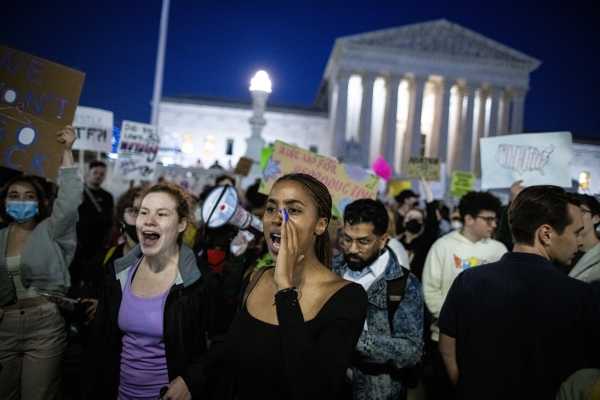
This story is part of a group of stories called

For decades, abortion has been treated as a fringe issue in American politics.
Sure, it made headlines when a new law passed or a new decision was handed down, and it was always deeply important to activists on both sides — as well as to many ordinary people, regardless of politics, who wanted to end a pregnancy.
For much of the 2000s and 2010s, though, abortion was routinely sidelined in presidential debates. It was compromised away when Democrats wanted to enlarge their tent by welcoming more socially conservative candidates and voters. Activists have campaigned for years to get politicians to even bring up abortion in speeches — President Joe Biden himself did not use the word until more than 200 days into his term, and then only in a written press statement, according to the abortion rights group We Testify.
In Democratic circles, especially, abortion has often been banished to the sidelines — it’s been seen as a social issue, or a “women’s” issue, as opposed to the kind of pocketbook matters that voters supposedly really care about. This kind of thinking has permeated media, too — “This Is A Story About Abortion, No One Will Read It,” Marie Solis wrote at Jezebel in 2020, detailing the way she and other reporters on the beat struggled to “get readers to care” about an issue that is intimately connected to economic, racial, and social justice, but often seemed all too easy to ignore.
Republicans, meanwhile, have taken advantage of this vacuum. Since the 1980s and especially since 2010, conservative politicians have made restricting abortion an explicit priority, and while Democrats have generally voiced support for reproductive freedom, they’ve rarely been as committed to upholding abortion rights as Republicans have been to dismantling them. That’s likely one of the reasons Republicans have been so successful in rolling back access to the procedure across large swaths of the country.
Now, at least for the moment, abortion is the center of attention on the left. A leaked draft opinion overturning the landmark abortion decision Roe v. Wade, written by Supreme Court Justice Samuel Alito and published by Politico on May 2, has captured the attention of Republicans and Democrats alike, inspiring protests around the country and wall-to-wall news coverage.
The overturning of Roe, now a near certainty, will lead to a loss of access more widespread than any single state law. Abortion will likely become illegal in 22 states, and 41 percent of women of childbearing age will see their nearest abortion clinic close, according to an analysis by the New York Times. The moment abortion rights supporters have been dreading — and abortion opponents have been eagerly awaiting — for the past 40 years has finally arrived.
The draft opinion is also momentous because it exposes how wrong it always was to consider abortion some kind of niche concern. A wholesale overturning of Roe as outlined in the Alito opinion won’t just allow states to ban abortion within their borders; it will also open the door for state officials to pursue legal action against abortion providers in other states, something some have already pledged to do. This situation — states pitted against each other over a major civil rights issue — has frightening parallels in American history.
It happened under slavery, when fugitive slave laws allowed authorities to return escaped enslaved people to their enslavers, even if they were on free soil. It happened, too, under Jim Crow, when Southern states enforced segregation in schools and throughout public life, sometimes in violation of federal law.
“When we see states trying to interfere with people being able to leave to get to freedom — oh, my goodness, we’ve seen that before,” said Michele Bratcher Goodwin, a law professor at UC Irvine and the author of the book Policing The Womb: Invisible Women and the Criminalization of Motherhood. “When we see the kinds of policing of people’s bodies and the surveilling of people who are trying to get to freedom, we’ve seen all of that before.”
That kind of policing and surveillance ultimately led to civil war. It’s too soon to say where the fall of Roe will lead, but one thing is certain: Today, abortion politics strikes at the heart of American democracy. The draft opinion heralds an uncertain future in which LGBTQ rights, the right to contraception, the legitimacy of the Supreme Court, and federalism itself are all in jeopardy. Anyone who still thinks of abortion as a side issue is about to be proved very wrong.
Abortion has been sidelined in liberal politics since the 1970s
The marginalization of abortion in Democratic politics is at least as old as Roe v. Wade. The 1973 decision, which established a constitutional right to an abortion, may have given liberals a false sense of security, Goodwin said. “There was a confidence that the United States was a country that would not roll back, and that would not reach back to its worst tendencies.”
It wasn’t just Roe. Americans had also seen the recent gains of the civil rights movement, including the Voting Rights Act and integration of schools, after brutal and sometimes bloody fights. There was “this sense that we can breathe now in the 1970s,” Goodwin said, “that now we can say we’ve learned from these horrors of the past and that we will not take lightly what respecting equality truly means under this flag.”
The gains of the 1960s and early 1970s quickly began to erode. In 1976, Congress enacted the Hyde Amendment, which bars federal funding for most abortions, thus putting the procedure out of reach for many low-income Americans. In 1984, President Ronald Reagan put in place the Mexico City policy, also known as the “global gag rule,” which bars organizations abroad that receive US foreign aid from performing or even discussing abortion. Later, in the 2000s, a steady march of state-level restrictions shut down clinics across the South and Midwest, making abortion access more and more difficult for people who couldn’t afford to drive hundreds of miles or spend thousands of dollars on a plane ticket.
Abortion was becoming a right that only the privileged — usually middle- and upper-class white women — could access. Those women did not rise up en masse to defend abortion access for others. There was a “failure to see that we all haven’t made it,” Goodwin said. “And when we all haven’t made it, the overall rights become vulnerable.”
Moreover, abortion was allowed to fall by the wayside in the Democratic Party. Beginning in the 1980s, Republicans began campaigning on an anti-abortion platform as a way to appeal to socially conservative voters, including Catholics. Democratic politicians generally supported abortion rights, but did not always push back vociferously on restrictions. The Hyde Amendment, for example, became a political third rail that many liberal candidates avoided touching for fear of upsetting centrists — overturning it did not become part of the Democratic Party platform until 2016, a full 40 years after it was first enacted.
Even then, abortion was often framed as something outside the mainstream of American politics, a social issue that could be easily separated from more important economic issues — even though the ability to decide when and how to become a parent has profound effects on birthing people’s finances and the entire economy.
In 2017, for example, Sen. Bernie Sanders and some Democrats endorsed Heath Mello, a Democratic candidate for mayor of Omaha, despite his past support of anti-abortion bills. While Sanders himself supports abortion rights, he said such compromises might be necessary “if we’re going to become a 50-state party.” It was part of a larger debate, that often went beyond Sanders himself, in which abortion was sometimes cast as an issue of “identity politics” that Democrats couldn’t afford to focus on if they wanted to win working-class voters. (In fact, it’s not at all clear that embracing anti-abortion candidates is a reliable strategy to win working-class votes, and a majority of Americans support Roe v. Wade.)
Sometimes abortion just didn’t get talked about at all. In 2016, activist Renee Bracey Sherman started the hashtag #AskAboutAbortion to encourage moderators at presidential debates to bring up the subject. She and others who participated in the campaign were frequently disappointed, as debate after debate went by without substantive discussion of the issue.
This inattention has been mirrored in media, where abortion coverage was often siloed at so-called women’s interest publications. Major media outlets rarely dedicated even a single reporter to the issues of reproductive rights and justice. Even reporters at publications like Jezebel that paid more attention to the topic often struggled to interest readers outside of brief flurries of activity around specific bans. In 2020, Solis recalled pitching her editor a piece about a new restriction on medication abortion, only to be told “that it was a good idea, and important to cover, but difficult to get anyone to read about. Even on a site like Jezebel, where a large swath of the audience is ostensibly interested in the topic, a reported piece on abortion was likely to get little engagement.”
Some of this was probably post-Roe complacency. Some of it was generational — as Solis noted, Gen Z and younger millennials, especially people of color, have often felt disconnected from an abortion rights movement that has long centered the concerns of white women. And some of it comes from prejudices rooted deep in American society, even on the left.
In America, there has been “a lingering disregard for the equality and the personhood of women,” especially Black and brown women, Goodwin said. Now that disregard has led us straight to the end of Roe.
Forty million women of reproductive age live in states that are likely to ban abortion when Roe is overturned. Those most impacted will be people who lack the money or other resources to travel to another state for the procedure — namely low-income Americans, especially Black people, Indigenous people, and other people of color. “Black and brown folks have been sounding the alarms for years and none of it was hyperbole,” Rep. Ayanna Pressley (D-MA) said in a statement on the draft opinion. “We know that our most vulnerable communities will bear the disproportionate brunt of any decision to restrict and deny access to abortion care.”
The opinion also has enormous implications for the future of American law. In a matter of months, nearly half of the United States will ban something that is seen by millions of Americans — and that has been protected for over 40 years by the US Constitution — as a crucial human right. Those states will also seek to extend the bans beyond their borders. Texas is already doing this, including an extradition provision in a recent restriction on medication abortion that would allow the state to prosecute residents elsewhere who send the pills into Texas.
Abortion opponents in Texas also hope to find ways to restrict abortions that Texans receive out of state. “All options are on the table,” John Seago, legislative director of Texas Right to Life, said in an April interview. “Our legislature is very motivated, and they’ll continue to be motivated even post-Roe.”
The larger legal implications of such efforts are immense. No one knows exactly what will happen when a state like Texas tries to prosecute abortion providers in a state like California, or what the courts will do if and when such prosecutions are challenged. Such a situation, however, eerily echoes divides between free and slave states prior to the Civil War, and between Southern and Northern states under Jim Crow.
The parallels become even more pronounced when you recognize that the populations most affected by the fall of Roe, especially Black Americans, were also those who had their rights stripped from them under slavery and Jim Crow, Goodwin pointed out. And some of the same states that enacted Jim Crow legislation are those seeking to ban abortion today. Those states also “still happen to have legislatures that are predominantly white, and overwhelmingly male,” Goodwin said. “They haven’t significantly changed.”
Interstate conflict over slavery, obviously, eventually gave rise to war. When states enshrined racial discrimination in law and practice under Jim Crow, it took a mass movement led by Black Americans — in which many were killed — to wrest back victories like Brown v. Board of Education and the Voting Rights Act. Even after Brown, President Dwight Eisenhower had to call in the National Guard so that nine Black students could go to school in Arkansas.
It’s far from clear what’s going to happen when half of US states ban abortion. What we know is that, as misguided as it always was to think of reproductive rights and justice as side issues, it’s now impossible to do so. If history is any guide, these issues are going to cause conflicts that shake the federalist system to its core.
Civil rights issues shouldn’t have to threaten the union or precipitate clashes between federal and state authorities to grab the attention of white, middle-class Americans, but that could very well be where we’re headed. Those who have had the luxury of not paying attention may not have it much longer.
Will you support Vox’s explanatory journalism?
Millions turn to Vox to understand what’s happening in the news. Our mission has never been more vital than it is in this moment: to empower through understanding. Financial contributions from our readers are a critical part of supporting our resource-intensive work and help us keep our journalism free for all. Please consider making a contribution to Vox today.
Sourse: vox.com






